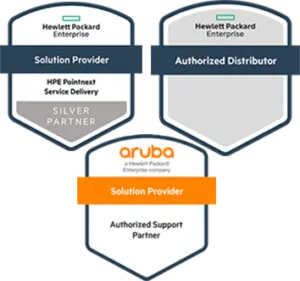
How HPE Can Help Micro to Midsize Businesses Achieve Secure IT Deployment
You can only try to maximize Return on Investment (ROI) with help from outside. HPE and its partners are here to help you get the most out of your resources, so your ROI goes up. Their combined skills, resources, and knowledge can help you make the best use of every dollar you spend on technology for your business.
Use HPE and its partners to get the most out of your IT investment and work. Find out what small and medium-sized businesses are like and what technology problems they face when implementing, managing, and securing IT solutions.
Defining Microbusinesses (Single Employee)

Microbusinesses, which are also called “zero-employee” businesses, often have people who work for themselves. These businesses, which include start-ups, gig workers, independent contractors, and professional service providers, still need reliable ways to make money.
Most of the time, these companies research and make purchases the same way that consumers do. However, they have technology standards that are good enough for business. Because of this, most small business owners only have a basic understanding of the pros and cons of technology.
Moreover, some people may have more in-depth knowledge because they’ve worked for larger companies and managed IT purchases and deployments. Often, these kinds of organizations buy technology to get their operations up and running or to meet a specific technology need.
How HPE and Its Partners Can Help Microbusinesses?
Microbusinesses can get a wide range of services and solutions from Hewlett Packard Enterprise (HPE). HPE has helped even the smallest businesses establish or grow their online presence. Their extensive network of partners can offer technology solutions and consulting services to help micro businesses maximize their resources and ROI.
HPE knows that small businesses need solutions that are simple and easy to use. The pricing needs to be unambiguous, and there shouldn’t be any hidden fees or charges. Because these kinds of organizations often need help understanding and translating technical differences into financial terms, the focus should be on business value and bottom-line benefits.
HPE is also aware that technology needs to be implemented quickly so that small businesses can save money and get back to work as soon as possible. They are willing to work with these customers to make this happen because they know that micro businesses often needs coaching that focuses on solving business problems.
What is a Small Business?
IDC says small businesses usually have between one and ninety-nine full-time equivalent (FTE) employees in all locations. A small office business, which usually has between one and nine employees, is an integral part of this mix. Different kinds of technology are needed for this category’s smaller and more significant parts. Also, small office operations (SOOs) are becoming more popular in all fields, including technology, retail, hospitality, and professional services.
According to the SBA Office of Advocacy99.9% of all businesses in the United States are small businesses. They make up 97.5% of all businesses that export and 99.7% of all businesses that pay people. In SOOs, one to nine employees do the daily work that three to four specialists usually do in a larger organization.
Flat hierarchies are standard in larger small businesses and SOOs, where employees manage workloads to meet customer needs. Most of the time, there are only some mid-level managers. Instead, the companies use a team-based method to handle work and train and guide new employees.
In small businesses, the final decision on what technology to buy is made by business executives, not technologists. Only 32.5% of small businesses worldwide have at least one full-time IT worker. Most of the time, between 50 and 99 people work for these companies, and technology is a big part of what they do. Even so, the IT staff in these organizations usually only have general IT skills. Those in those positions are likely junior employees who report to a senior manager who makes budget decisions.
How HPE and Its Partners Can Help Small Businesses?
HPE knows that small businesses, from those with one employee to those with more than ten, need quick, clear answers and content highlighting the company’s value and advantages. They avoid buzzwords and jargon in this information so small business employees, and managers can understand what the options can do and how much they cost.
HPE explains a product or service using IT jargon so small business owners can use it. Most importantly, HPE and its partners want to ensure that small businesses have the tools to keep going. They depend on these tools to give them the necessary knowledge and technologies. They are happy to help with coaching or advice when needed.
What is a Midsize Business?
IDC says that between 100 and 999 FTEs work for midsize businesses in the Americas and Japan. The most FTE employees that a midsize business can have worldwide is 499. IDC compares these businesses to teenagers because they don’t need as much help as small businesses but aren’t big enough to have all the resources and skills of larger businesses.
At this point in the growth and development of a company, the organizational structure changes from flat to hierarchical. It means that companies “departmentalize,” which means that staff roles get smaller and more specialized.
Midsize businesses often have a lot of “technical debt.” The current technology may be outdated or insufficient to keep up with the growing demands and complexity. At this level, some senior talent helps the IT department grow.
Even though IT jobs are getting more specialized, talent is still spread out. It needs to be more concentrated in larger businesses. Talent in demand is often hard to find because larger, better-funded companies can outbid smaller ones for scarce talent pools.
Most of the time, midsize businesses decide what to buy by reaching a consensus. Senior staff oversees the selection process and leads the research. They do this with the help of line-of-business (LOB) leaders. CIOs may report to CFOs or COOs, depending on the size and structure of the midsize business.
It means that high-value items most likely need formal approval or buy-in. It is especially true for technologies that people use themselves, like software or computer equipment.
How HPE and Its Partners Can Help Midsize Businesses?
HPE knows that information for midsize businesses must be short and business-focused while providing enough product details to set its products apart from competitors.
IT teams must share product and service information with a high-level business decision-maker who may need a technical background. Because of this, there is still a need to define and explain buzzwords and jargon.
How HPE (and Partners) Can Secure Your IT

A quick look shows that HPE offers reliable, comprehensive, and cutting-edge cybersecurity solutions. Its security features starts with the hardware and cover hardware-based users and systems at the network’s edge. The goal is to collect and analyze security intelligence to stay ahead of threats, protect business-use systems and services, and help clients manage and lower security risks.
HPE Security Starts with Its Servers
HPE is one of the biggest companies in the world that makes industry-standard servers the safest. Its ProLiant server family has won a lot of awards and honors, in part because of the following features:
Protect
Using a silicon root of trust, improved trusted platform modules (TPM), multiple levels of tamper-proofing, and other HPE innovations like “Integrated Lights Out” (iLO) firmware protects systems from hardware and firmware attacks.
Detect
iLO wipes potentially (or actually) compromised firmware code and, if possible, replaces it with a known-valid copy during boot integrity checks. Systems won’t be able to start up (it provides pre-boot protection against rootkits and other insidious firmware-based attacks).
Recover
Thanks to backups that can’t be changed and restore mechanisms that are safe and secure, systems can be quickly and easily brought back to their last known good, working state.
HPE Security Solutions
HPE’s security tools, technologies, and solutions are made using three main approaches. The best way to describe these is as follows:
Data-centric security
Data protection is the primary goal of security measures, especially regarding sensitive data (personally identifiable information, or PII; accounts and passwords; financial, health, or other legally protected data, and so forth). It has everything to do with the strategy below: who can access systems and data and why.
Zero-trust security
The National Institute of Standards and Technology (NIST) says, “Never trust; always verify” is the definition of Zero Trust (ZT). It puts data and services at the top of its list. Still, it must protect all devices, infrastructure, applications, virtual and cloud resources, and topics (users, applications, services, and systems). ZT is based on the idea that attackers are always there and doing something. So, it doesn’t assume anything about people and always looks at the risks to assets and business operations.
The “Principle of Least Privilege,” also called “PLP,” says that no subject should have more rights than they need to do their jobs.
DevSecOps
It is an evolution of the DevOps idea, which brings operations staff (administrators, tech support, and field technicians or troubleshooters) and developers into a single organization with shared goals and objectives. DevSecOPs integrate the security team throughout the whole development lifecycle, taking security into account during the phases of design, construction, testing, maintenance, and retirement in business IT operations.
Conclusion
Secure IT deployment is the key to high productivity in small and medium-sized businesses. With HPE’s reliable and secure IT solutions, businesses can deploy IT in a reliable and cost-effective way. HPE’s resources cover all of the essential parts of deploying IT securely, such as network security, data and application security, asset management, compliance, and lowering costs. Lastly, HPE can help these businesses improve the security of their data and systems, as well as the experience of their users. So, if you’re ready to improve the secure IT deployment at your company, HPE is here to help.
HPE ProLiant servers, storage, and networking solutions are all available from ICT Distribution Bangladesh. Our staff will provide our customers with the best service and assistance possible. So, what’s holding you back? Syed Adnan, our country manager, can be reached at syed.adnan@ictdistribution.net.
Latest Posts



Comparing HPE Storage Server Models: Which One Suits Your Needs?

How HPE’s Innovations Are Shaping the Next Decade of Technology

Beyond Antivirus: Why Kaspersky Total Security is Your 2024 Digital Guardian


Comparing HPE Storage Server Models: Which One Suits Your Needs?



